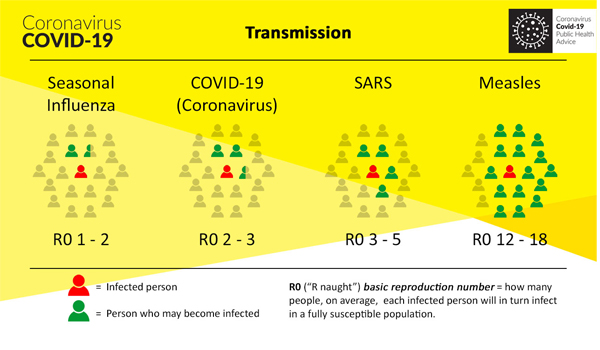The incubation period is the time between exposure to the virus and developing symptoms. With an emerging disease, we do not already know this number and need to estimate it using data from patients. On average, the incubation period for Covid-19 is 5 days but ranges from 2 to 14 days.
Infectious period
A similar number to the incubation period that helps to define a virus and an outbreak is the infectious period. Estimates vary for mild cases versus severe cases. If mild cases are symptomatic, they are typically symptomatic for about 2 weeks, and severe cases are symptomatic for 3 to 6 weeks. Although we are still unsure if someone can begin transmitting the virus without symptoms, a good estimate for the infectious period is how long someone is symptomatic.
Basic reproductive number
Another important number in the dynamics of an infectious disease is the basic reproductive number (R0), the number of cases an infectious individual is likely to infect in a completely susceptible population. For an emerging disease, this number is extremely important because the population is entirely susceptible. The higher the R0, the faster the disease will spread. A very infectious disease has a high R0, and a less infectious disease has a lower R0. For example, measles has an R0 between 12 and 18, while influenza has an R0 between 1 and 2. Estimates for the R0 of Covid-19 range from 2 to 6.28.
R0 is dependent on a number of factors: the number of contacts per time, the time per infection and the number of infections per contact. Unlike the infectious period or the incubation period, we can influence R0 by changing our contact patterns and reducing contacts decreases R0. This is why social distancing is an important programme against Covid-19. If the disease has an R0 less than 1, the outbreak will die out, but the disease will spread if the R0 is greater than 1.
Why is it important to understand these numbers?
Knowing just the infectious period, the incubation period and the basic reproductive number, a compartmental susceptible, exposed, infected and recovered equation-based model (SEIR) can be run. A SEIR model is made up of differential equations that determine the rate the population moves between different compartments: from susceptible to exposed, exposed to infected or infected to recovered. This type of model has been used historically and is still used to model the spread of infectious diseases and captures the general outbreak dynamics. However, they model at a population level and do not take into account individual behaviours or specific characteristics of a city, region or country that can drive a pandemic or slow one down.
Characteristics such as transportation networks, population density and individual actions are important in determining the susceptibility of a population to an outbreak, so agent-based models have become popular. These are computer simulations that model each individual person in a society as an agent in the model. Agents make decisions based on a set of rules. They can decide to stay home when sick, go to work or practice social distancing. The same parameters that model the infectious disease in an SEIR model are used in the agent-based model to determine how long agents are exposed, how long agents are infectious and the likelihood of infecting a contact.
Models show the importance of social distancing in slowing the spread of the coronavirus and flattening the curve to prevent overloading our healthcare system
The agents' ability to make decisions and their interactions with each other and their environment produce results that might not have been otherwise obvious. The Episimdemics model showed that keeping troops in barracks during an influenza outbreak might increase the number infected because troops sequestered together are in prolonged contact and individuals who have not yet shown symptoms will spread the flu to almost everyone else. These not obvious results are important in understanding how interventions influence disease spread.
Models help us to learn as much as possible about outbreaks before they occur, to understand what interventions are best to slow or stop an outbreak, and how to respond to an outbreak in real-time. Models are already being run to show the importance of social distancing in slowing the spread of the coronavirus and flattening the curve to prevent overloading our healthcare systems. As the social and economic impacts of the pandemic are becoming clearer, it's important to have an understanding of how any measures to slow the spread of a disease will actually work.
This article was originally published by RTÉ Brainstorm.
Elizabeth Hunter is a PhD researcher at the School of Computer Science at TU Dublin and you can read more of Elizabeth's work about models for epidemiology below.
A Comparison of Agent-Based Models and Equation Based Models for Infectious Disease Epidemiology
An open-data-driven agent-based model to simulate infectious disease outbreaks
A Taxonomy for Agent-Based Models in Human Infectious Disease Epidemiology

